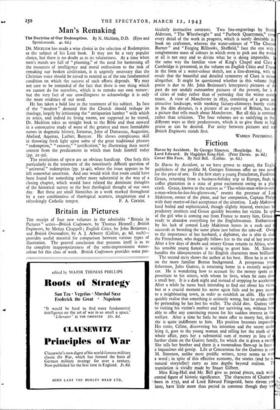Britain in Pictures
THE receipt of four new volumes in the admirable "Britain in Pictures" series—British Craftsmen, by Thomas Hennell • British Engineers, by Metius Chappell ; English Cities, by John Btjeman • and British Orientalists, by A. J. Arberry (Collins, 4s. 6d. each)-1 provides useful material for comparison between various types of illustration. The general conclusion that presents itself is as to the complete inappropriateness of the semi-impressionist water- colour for this class of work. British Craftsmen provides some par- ticulirly instructive contrasts. Two line-engravings by Stanl Alderson, "The Wheelwright" and "Purbeck Quarrymen," rev every detail of the work in progress, which is surely desirable in book on craftsmen, whereas the water-colours of "The Charco Burner" and "Forging Billhooks, Sheffield," face the eye with conglomerate mass of colours in which even to pick out the work at all is not easy and to divine what he is doing impossible. the same way the familiar view of King's Chapel and Clare Cambridge is presented, in the volume on English Cities and Town in the form of a water-colour sketch, not a line-drawing, with th result that the beautiful and detailed symmetry of Clare is misse altogether. It might be questioned whether in this volume (hig praise is due to Mr. John Betjeman's letterpress) pictures of th past do not undnly outnumber pictures of the present, for it of cities of today rather than of yegterday that the writer main] treats. A view of Manchester in 1835, consisting of a green an attractive landscape, with smoking factory-chimneys barely visibl in the dim distance, is a picture of an aspect of Britain, but no a picture that tells much about Manchester. But all this is comme rather than criticism. The four volumes are as satisfying in the different ways as their predecessors, which is to give them as hig praise as can be desired. For unity between pictures and te British Engineers stands first.
WARREN POSTBRIDGE.


























 Previous page
Previous page